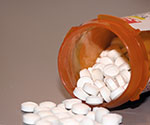 Almost half of all schizophrenics consume narcotics, nicotine, or alcohol. The reason for this addiction could be the very treatments these patients are undergoing, according to a new preclinical study published in Neuropsychopharmacology. “The secondary effects of antipsychotic drugs are numerous and invasive: facial tics, apathy, depression, weight gain, etc.,” says Anne-Marie Bédard, a Université de Montréal master’s student of pharmacology and lead author of the study.
Almost half of all schizophrenics consume narcotics, nicotine, or alcohol. The reason for this addiction could be the very treatments these patients are undergoing, according to a new preclinical study published in Neuropsychopharmacology. “The secondary effects of antipsychotic drugs are numerous and invasive: facial tics, apathy, depression, weight gain, etc.,” says Anne-Marie Bédard, a Université de Montréal master’s student of pharmacology and lead author of the study.
“Schizophrenics suffer, even when treated and many believe they consume other stimulants to appease the secondary effects. But, in fact, it only makes the situation worse. The risk of hospitalization increases and the potential success of the treatment decreases.”
The study demonstrated that the continuous, but not intermittent, delivery of antipsychotic drugs combined with an injection of amphetamine intensifies the pursuit of reward cues in rats. In humans, this translates into an uncontrollable craving for the sensation brought upon by drug consumption, for instance.
Antipsychotic drugs block certain dopamine receptors in the central nervous system, which over the long term can provoke a hypersensitivity to dopamine. This translates into a strong reaction to drugs, including amphetamines.
In her study, Bédard conducted three experiments on three groups of rats: a control group, a group receiving haloperidol (a common antipsychotic drug) continuously, and a group receiving haloperidol intermittently.
The first experiment evaluated the pursuit of a conditioned reward. The animals were used to seeing a light and hearing a sound whenever a reward was delivered, in this case a few drops of water. Once this Pavlovian association was learned the water was cut but the light and sound could still be activated with a pedal. A second pedal played a similar role but was inoperative. The rats then explored the role of both these pedals before receiving a dose of amphetamine.
The group receiving continuous doses of haloperidol pushed on the active pedal more than 150 times to obtain the light and sound. However, the group receiving haloperidol intermittently only pushed on the pedal fifty or so times.
In the second experiment, two genes were used to measure the cellular activity of this extreme behavior. Finally, in the third experiment, the rats were in a plexiglass cage and their movements were recorded using motion captors. The group receiving continuous doses of haloperidol was much more agitated than the two other groups.
Bédard concludes that: “the chronic consumption of antipsychotic drugs in schizophrenic individuals who consume drugs could intensify their addiction. However, this needs to be confirmed in clinical studies.”
Bédard conducted her study with the help of her research director Dr. Anne-Noël Samaha, student Jérôme Maheux and Professor Daniel Lévesque.
Material adapted from University of Montreal.
No comments yet.